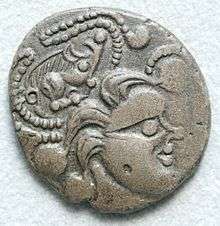Bodiocasses
The Bodiocasses (also Baiocasses) were an ancient Gallic tribe of the Roman period. They were a tribal division of the civitas of the Lexovii, in the Roman province of Gallia Lugdunensis.

Name
They are mentioned as Bodiocasses by Pliny (1st c. AD),[1] as Ou̓adikássioi (Οὐαδικάσσιοι) by Ptolemy (2nd c. AD),[2] as Baiocassi by Ausonius (4th c. AD),[3] and as Baiocas in the Notitia Dignitatum (5th c. AD).[4][5]
The name Bodio-casses stems from Gaulish bodios ('yellow, blond'), ultimately from Proto-Celtic *bodyo- ('yellow'; see Old Irish buide, 'yellow').[6][7] The meaning of the second element -casses is less certain, possibly 'hair, hairstyle', perhaps a particular warrior coiffure, or 'tin, bronze (helmet?)'.[8] Thurneysen has compared the name with the Old Irish buide-chass ('blond-curled').[6]
The city of Bayeux, attested as civitas Baiocassium ca. 400 CE ('civitas of the Baiocasses', Baiocas in 400–410, Baieus in 1155) is named after the Gallic tribe.[9][6] The region of Le Bessin, attested as pagus Baiocassinus in 840 CE ('pagus of the Baiocasses', Beissin in 1050–1066) also stems from the tribal name.[10]
History
Julius Caesar does not mention the Baiocasses in his commentaries on the Gallic Wars (58–50 BCE), but they are listed in the Notitia dignitatum and are probably the same people Pliny calls Bodiocasses.[11][6]
The Baiocasses minted base gold, silver and billon (base silver) coins in the denomination of one stater and in the case of gold coins sometimes quarter staters. Most of the coins show a Celtic-style male head with elaborated hair on the obverse, and on the reverse a horse with a chariot rider above or behind, and below usually either a lyre or small boar. A number of these are in existence.[12]
The 4th-century Bordelaise poet Ausonius teases a friend as a Baiocassis who claimed to be of druidic heritage and descended from priests of Belenus.[13]
References
- Pliny. Naturalis Historia, 4:107
- Ptolemy. Geōgraphikḕ Hyphḗgēsis, 2:8:11
- Ausonius. Professores, 11, 4:7
- Notitia Dignitatum. oc. 42, 34
- Falileyev 2010, p. entry 984.
- Delamarre 2003, p. 63.
- Matasović 2009, p. 70.
- Delamarre 2003, pp. 109–110.
- Nègre 1990, p. 152.
- Nègre 1990, p. 424.
- Pliny, Natural History 4.107 (Latin edition).
- BAIOCASSES - BAIOCASSES - (Région de BAYEUX) - (Ier siècle avant J.-C.) - Statère d'argent fourré - c. 60-50 AC. - VSO 15.
- Ausonius, Commemoratio professorum Burdigalensium 4.7; Altay Coşkun with Jürgen Zeidler, "'Cover Names' and Nomenclature in Late Roman Gaul: The Evidence of the Bordelaise Poet Ausonius" (2003), pp. 6–7.
Bibliography
- Delamarre, Xavier (2003). Dictionnaire de la langue gauloise: Une approche linguistique du vieux-celtique continental (in French). Errance. ISBN 9782877723695.CS1 maint: ref=harv (link)
- Falileyev, Alexander (2010). Dictionary of Continental Celtic Place-names: A Celtic Companion to the Barrington Atlas of the Greek and Roman World. CMCS. ISBN 978-0955718236.
- Matasović, Ranko (2009). Etymological Dictionary of Proto-Celtic. Brill. ISBN 9789004173361.CS1 maint: ref=harv (link)
- Nègre, Ernest (1990). Toponymie générale de la France (in French). Librairie Droz. ISBN 978-2-600-02883-7.CS1 maint: ref=harv (link)
See also
- Gaul
- List of peoples of Gaul
- List of Celtic tribes
